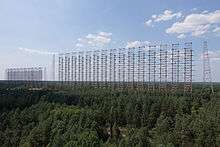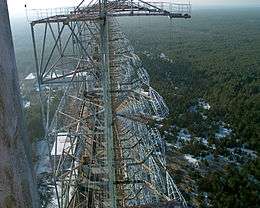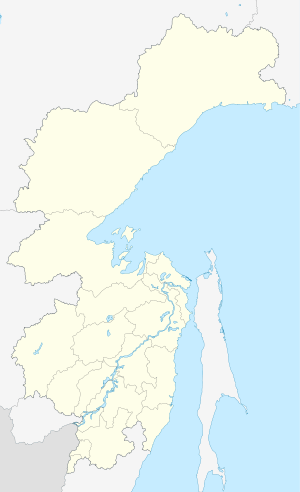Duga radar
Duga (Russian: Дуга́, literally "arc" or "curve") was a Soviet over-the-horizon radar (OTH) system used as part of the Soviet missile defense early-warning radar network. The system operated from July 1976 to December 1989. Two operational Duga radars were deployed, one near Chernobyl and Chernihiv in the Ukrainian SSR (present-day Ukraine), the other in eastern Siberia.


The Duga systems were extremely powerful, over 10 MW in some cases, and broadcast in the shortwave radio bands. They appeared without warning, sounding like a sharp, repetitive tapping noise at 10 Hz repetition rate,[1] which led to it being nicknamed by shortwave listeners the Russian Woodpecker. The random frequency hops disrupted legitimate broadcasts, amateur radio operations, oceanic commercial aviation communications, and utility transmissions, resulting in thousands of complaints by many countries worldwide. The signal became such a nuisance that some receivers used on amateur radio and television, such as the Datong Model SRB2 Auto Woodpecker Blanker, began including 'Woodpecker Blankers' in their circuit designs in an effort to filter out the interference.[2]
The unclaimed signal was a source for much speculation, giving rise to theories such as Soviet mind control and weather control experiments. However, because of its distinctive transmission pattern, many experts and amateur radio hobbyists quickly realized it to be an over-the-horizon radar system. NATO military intelligence had already given it the reporting name STEEL WORK or STEEL YARD likely based on the massive size of the transmitter which spanned 700 m in length and 150 m (492 ft) in height[3] . While the amateur radio community was well aware of the system, this theory was not publicly confirmed until after the fall of the Soviet Union.
History
Genesis
The Soviets had been working on early warning radar for their anti-ballistic missile systems through the 1960s, but most of these had been line-of-sight systems that were useful for rapid analysis and interception only. None of these systems had the capability to provide early warning of a launch, within seconds or minutes of a launch, which would give the defences time to study the attack and plan a response. At the time, the Soviet early-warning satellite network was not well developed. An over-the-horizon radar sited in the USSR would help solve this problem, and work on such a system for this associated role started in the late 1960s.
The first experimental system, Duga, was built outside Mykolaiv in Ukraine, successfully detecting rocket launches from Baikonur Cosmodrome at 2,500 kilometers (1500 miles). This was followed by the prototype Duga, built on the same site, which was able to track launches from the far east and submarines in the Pacific Ocean as the missiles flew towards Novaya Zemlya. Both of these radar systems were aimed east and were fairly low power, but with the concept proven, work began on an operational system. The new Duga-1 systems used a transmitter and receiver separated by about 60 km (40 miles).[4]

"Russian Woodpecker"
At some point in 1976, a new and powerful radio signal was detected simultaneously worldwide, and quickly dubbed 'the Woodpecker' by amateur radio operators. Transmission power on some Woodpecker transmitters was estimated to be as high as 10 MW equivalent isotropically radiated power.[5][6] Even prior to 1976, a similar 'woodpecker' interference is remembered by radio amateurs occurring in the high frequencies. As early as 1963, or before, radio amateurs were calling this "the Russian Woodpecker" . Little is known about the power levels or Russian designation but it was probably a forerunner of the Duga radar systems. It was also speculated at that time, at least among radio amateurs, that this was an over-the-horizon radar.
Triangulation by both amateur radio hobbyists and NATO quickly revealed the signals came from a location in present-day Ukraine, at the time called Ukrainian Soviet Socialist Republic (part of USSR). Confusion due to small differences in the reports being made from various sources led to the site being variously located near Kiev, Minsk, Chernobyl, Gomel or Chernihiv. All of these reports were describing the same deployment, with the transmitter only a few kilometers (miles) southwest of Chernobyl (south of Minsk, northwest of Kyiv) and the receiver about 50 km (30 miles) northeast of Chernobyl (just west of Chernihiv, south of Gomel). At one time there was speculation that several transmitters were in use.[5]
The radar system was given the code 5Н32-West by the Soviets, and was set up in two closed towns, Liubech-1 held the two transmitters and Chernobyl-2 the receivers.[6] Unknown to civilian observers at the time, NATO was aware of the new installation. A second installation was built near Komsomolsk-on-Amur, in Bolshya Kartel and Lian, but did not become active for some time.
NATO Reporting Name
The NATO Reporting Name for the Duga-1 is often quoted as STEEL YARD. Many online and several print references use this name. However some sources also use the term STEEL WORK (or STEEL WORKS). As any "official" sources using NATO Reporting Names are likely to be classified, establishing the true name will be difficult. The earliest found open source mention of a NATO Reporting Name for this system, a reference publication in print while the system was still active, unambiguously uses the term STEEL WORK.[7]
Civilian identification
Even from the earliest reports it was suspected that the signals were tests of an over-the-horizon radar,[5] and this remained the most popular hypothesis during the Cold War. Several other theories were floated as well, including everything from jamming western broadcasts to submarine communications. The broadcast jamming theory was discarded early on when a monitoring survey showed that Radio Moscow and other pro-Soviet stations were just as badly affected by woodpecker interference as Western stations.
As more information about the signal became available, its purpose as a radar signal became increasingly obvious. In particular, its signal contained a clearly recognizable structure in each pulse, which was eventually identified as a 31-bit pseudo-random binary sequence, with a bit-width of 100 μs resulting in a 3.1 ms pulse.[8] This sequence is usable for a 100 μs chirped pulse amplification system, giving a resolution of 15 km (10 mi) (the distance light travels in 50 μs). When a second Woodpecker appeared, this one located in eastern Russia but also pointed toward the US and covering blank spots in the first system's pattern, this conclusion became inescapable.
In 1988, the U.S. Federal Communications Commission (FCC) conducted a study on the Woodpecker signal. Data analysis showed an inter-pulse period of about 90 ms, a frequency range of 7 to 19 MHz, a bandwidth of 0.02 to 0.8 MHz, and typical transmission time of 7 minutes.
- The signal was observed using three repetition rates: 10 Hz, 16 Hz and 20 Hz.
- The most common rate was 10 Hz, while the 16 Hz and 20 Hz modes were rather rare.
- The pulses transmitted by the woodpecker had a wide bandwidth, typically 40 kHz.
Jamming the Woodpecker
To combat this interference, amateur radio operators attempted to jam the signal by transmitting synchronized unmodulated continuous wave signals at the same pulse rate as the offending signal. They formed a club called The Russian Woodpecker Hunting Club.[9] Core group members would frame the "Official Practice Target" in their radio shacks.[10]
Signal Disappearance
Starting in the late 1980s, even as the FCC was publishing studies, the signals became less frequent, and in 1989, they disappeared altogether. Although the reasons for the eventual shutdown of the Duga systems have not been made public, the changing strategic balance with the end of the Cold War in the late 1980s likely had a major part to play. Another factor was the success of the US-KS early-warning satellites, which began entering service in the early 1980s, and by this time had grown into a complete network. The satellite system provides immediate, direct and highly secure warnings, whereas any radar-based system is subject to jamming, and the effectiveness of OTH systems is also subject to atmospheric conditions.
According to some reports, the Komsomolsk-na-Amure installation in the Russian Far East was taken off combat alert duty in November 1989, and some of its equipment was subsequently scrapped. The original Duga-1 site lies within the 30 kilometer (20 mile) Zone of Alienation around the Chernobyl power plant. It appears to have been permanently deactivated, since their continued maintenance did not figure in the negotiations between Russia and Ukraine over the active Dnepr early warning radar systems at Mukachevo and Sevastopol. The antenna still stands and has been used by radio amateurs visiting the area using their own portable radio equipment.
Locations

The original Duga was the first experimental system.[11][12] It was built outside the Black Sea port of Mykolaiv in the southern Ukraine, and successfully detected rocket launches from Baikonur Cosmodrome about 2,500 kilometers (1500 miles) away. Duga is able to track launches from the Far East and from submarines in the Pacific Ocean, as the missiles fly towards Novaya Zemlya in the Arctic Ocean. This huge radar complex was restored in 2002 after a fire seriously damaged it. The transmitter is located at 46°48′26″N 32°13′12″E and the receiver at 47°02′28.33″N 32°11′57.29″E.
The original Duga was supplanted by a pair of installations: western, Duga-1, and eastern, Duga-2. Duga-1 was built in northern Ukraine, between Liubech and Chernobyl-2. The receiver is located at 51°18′19.06″N 30°03′57.35″E a few kilometers (miles) west-north-west of Chernobyl; the transmitter is located at 51°38′15.98″N 30°42′10.41″E about 50 km (30 miles) northeast of Chernobyl (just west of Chernihiv, south of Gomel). The site is open for pre-arranged visits, for which a permit must be obtained in advance; it has been open since approximately 28 October 2013. Operators who provide tours of Chernobyl and the surrounding areas are able to obtain the relevant paperwork.
Duga-2, the eastern system, is located near Komsomolsk-on-Amur in Khabarovsk Krai, with the receiver at 50°23′07.98″N 137°19′41.87″E, some 30 km (20 miles) southeast of the city, and the transmitter at 50°53′34.66″N 136°50′12.38″E, 45 km (30 miles) north of the city.
Appearances in media
The Ukrainian-developed computer game S.T.A.L.K.E.R. has a plot focused on the Chernobyl Nuclear Power Plant and the nuclear accident there. The game features many actual locations in the area, including the Duga-1 array. The array itself appears in S.T.A.L.K.E.R.: Clear Sky in the fictional city of Limansk-13. While the 'Brain Scorcher' from S.T.A.L.K.E.R.: Shadow of Chernobyl was inspired by theories that Duga-1 was used for mind control, it does not take the form of the real array.
Markiyan Kamysh's novel about illegal trips to the Duga, A Stroll to the Zone, was praised by reviewers as the most interesting literature debut of 2015 in Ukraine. The novel has been translated into French (with the title La Zone), and was published by French publishing house Arthaud (Groupe Flammarion).
In Call of Duty: Black Ops, the map "Grid" is placed in Pripyat near the DUGA-1 array.
The 'Russian woodpecker' appears in Justin Scott's novel The Shipkiller.
The Duga at Chernobyl was the focus of the 2015 documentary film, The Russian Woodpecker, by Chad Gracia. The film includes interviews with the commander of the Duga, Vladimir Musiets, as well as the Vice-Commander, the Head of the Data Center, and others involved in building and operating the radar. The documentary, which won numerous awards, also includes drone video footage of the array and handheld video footage of the surroundings as well as a climb to the top by the cinematographer, Artem Ryzhykov. The film also proposes a conspiracy theory that the Chernobyl disaster was engineered to cover up failures in the radar's design.[13]
The Duga radar is also featured in the films of the Divergent series, where it was used as the giant wall and fence surrounding the main city. In wide shots, its structure was used to create CGI images of the superstructure and several close-up scenes were shot directly at its location.
A Duga radar is featured in the 2017 game Player Unknown's Battlegrounds in a map which portrays a fictional Russian Military base.
The Duga radar is heavily featured in the Virtual reality game "Proze : Enlightenment" a suspense/puzzle game with the theory that the radar is being used by mind controlling experiments during the 1950-60s The game actually starts with the player ascending one of the pylons on a maintenance lift.[14]
See also
- Cobra Mist
- Jindalee Operational Radar Network, a similar Australian system.
- The Montauk Project
- Numbers station
- The Buzzer
- Container (29B6) radar, new Russian OTH Radar with similar radio interference to the Duga.
References
- David L. Wilson (Summer 1985). "The "Russian" (sic) Woodpecker... A Closer Look". Monitoring Times. Retrieved 2019-04-08.
- https://www.americanradiohistory.com/Archive-DX/Ham-Radio-Today/80s/HRT-1984-02.pdf
- https://www.cnn.com/travel/article/duga-radar-chernobyl-ukraine/index.html#:~:text=The%20Duga%20radar%20(which%20translates,almost%20700%20meters%20in%20length.
- Bukharin, Oleg; et al. (2001). Pavel Podvig (ed.). Russian Strategic Nuclear Forces. Cambridge, Massachusetts: MIT Press.
- "Mystery Soviet over-the-horizon tests". Wireless World: 53. February 1977. Retrieved 2019-04-08.
- Nazaryan, Alexander (18 April 2014). "The Massive Russian Radar Site in the Chernobyl Exclusion Zone". Newsweek.
- The International Countermeasures Handbook, 14th Edition. Englewood, Colorado, USA: Cardiff Publishing. 1989.
- J.P. Martinez (April 1982). "Letter from J. P. Martinez". Wireless World: 89. Retrieved 2019-04-08.
- Dave Finley (7 July 1982). "Radio hams do battle with 'Russian Woodpecker' Some hams informally attempted to jam the woodpecker by tapping a microphone with a pencil emulating the woodpecker's signal while transmitting on the ham voice subbands". The Miami Herald. Retrieved 2007-06-15.
- Brian Rogers, RUSSIAN WOODPECKER HUNTING CLUB OFFICIAL PRACTICE TARGET
- John Pike. "Steel Yard OTH". GlobalSecurity.org. Retrieved 2010-04-08.
- A. Karpenko Nevsky Bastion (1999). "ABM AND SPACE DEFENSE". No. 4: 2–47. Cite journal requires
|journal=(help) - The Russian Woodpecker documentary (2015)
- http://signsine.com/proze-vr/
Further reading
- Headrick, James M. (1 July 1990). "Looking over the horizon (HF radar)". IEEE Spectrum. 27 (7): 36–39. doi:10.1109/6.58421.
- Headrick, James M.; Skolnik, Merrill I. (1 January 1974). "Over-the-Horizon radar in the HF band". Proceedings of the IEEE. 62 (6): 664–673. doi:10.1109/PROC.1974.9506. S2CID 32258331.
- Headrick, James M., Ch. 24: "HF over-the-horizon radar," in: Radar Handbook, 2nd ed., Merrill I. Skolnik, ed. [New York: McGraw-Hill, 1990].
- Kosolov, A. A., ed. Over-the-Horizon Radar (translated by W. F. Barton) [ Norton, Mass.: Artech House, 1987].
- John Pike. "Steel Yard OTH". GlobalSecurity.org. Retrieved 2010-04-08.
External links
| Wikimedia Commons has media related to Duga-1 radar. |
- Chernobyl-2. Secret Military Facility in the territory of exclusion zone. Text and photos 2008
- OTH-Radar "Chornobyl - 2" and Center of space-communication
- "Circle" is an auxiliary system for OTH-Radar "Chornobyl - 2"
- The Russian Woodpecker, Miami Herald, July 1982.
- Steel Yard OTH, globalsecurity.org
- Some pictures of Chernobyl-2
- 'Duga' photos at englishrussia.com
- Chernobyl-2
- The Top Secret Military Base Hidden in Chernobyl’s Irradiated Forest
- Obsidian Urbex Photography | Photos taken in 2016